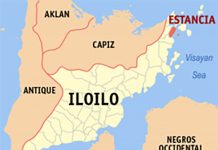[av_one_full first min_height=” vertical_alignment=” space=” custom_margin=” margin=’0px’ padding=’0px’ border=” border_color=” radius=’0px’ background_color=” src=” background_position=’top left’ background_repeat=’no-repeat’ animation=”]
[av_heading heading=’Indoor spraying vs Zika mosquitoes set ‘ tag=’h3′ style=’blockquote modern-quote’ size=” subheading_active=’subheading_below’ subheading_size=’15’ padding=’10’ color=” custom_font=”]
BY GLENDA SOLOGASTOA
[/av_heading]
[av_textblock size=” font_color=” color=”]
ILOILO City – The Department of Health (DOH) will conduct “indoor residual spraying” (IRS) against Zika mosquitoes in all Barangay Benedicto houses in Jaro district tomorrow.
It considers Barangay Benedicto a high-risk area for dengue, Zika and chikungunya diseases – all mosquito-borne.
IRS is the application of long-acting chemical insecticides on the walls and roofs of houses and domestic animal shelters in a given area to kill the adult vector mosquitoes that land and rest on these surfaces.
DOH announced the conduct of IRS during yesterday’s pulong-pulong (assembly) in Barangay Benedicto. Three village residents tested positive for the Zika virus.
Twelve DOH teams will do the spraying in the village’s nine sitios. Each team is expected to cover 50 to 70 houses.
Representatives from the Research Institute for Tropical Medicine (RITM) explained to the residents the helpful effects of indoor residual spraying.
RITM is the research facility of DOH. It undertakes research in the prevention, diagnosis and treatment of tropical diseases of public health importance.
Iloilo City’s Zika infections are the first cases of the virus transmitted or acquired locally, not from any Zika endemic country.
In Brazil, pregnant women infected with the Zika virus gave birth to babies with microcephaly (abnormally small heads and severe developmental issues).
Barangay Benedicto residents were told to leave their houses tomorrow morning and stay away from them for three hours after the spraying.
World Health Organization’s (WHO) manual for IRS listed the following procedures for households before the spraying:
* Remove all household items, including water, food, cooking utensils and toys, from the house. Move and cover, or remove, any furniture to allow easy access for spraying walls. Items that cannot be removed should be well covered.
* Cage or tether pets and domestic animals away from the house.
WHO also listed the following things households must do after spraying:
* Household occupants should stay outside until the spray is dry.
* Householder should sweep or mop the floor before children or pets are allowed to re-enter.
* Householder should not to clean the sprayed surfaces.
According to WHO, where indoor residual spraying is used, it is essential that staff are fully trained in application techniques and maintenance of the application equipment.
With good skills and high-quality application equipment, hazards to human health and the environment as well as financial losses can be avoided, it stressed./PN
[/av_textblock]
[/av_one_full]



